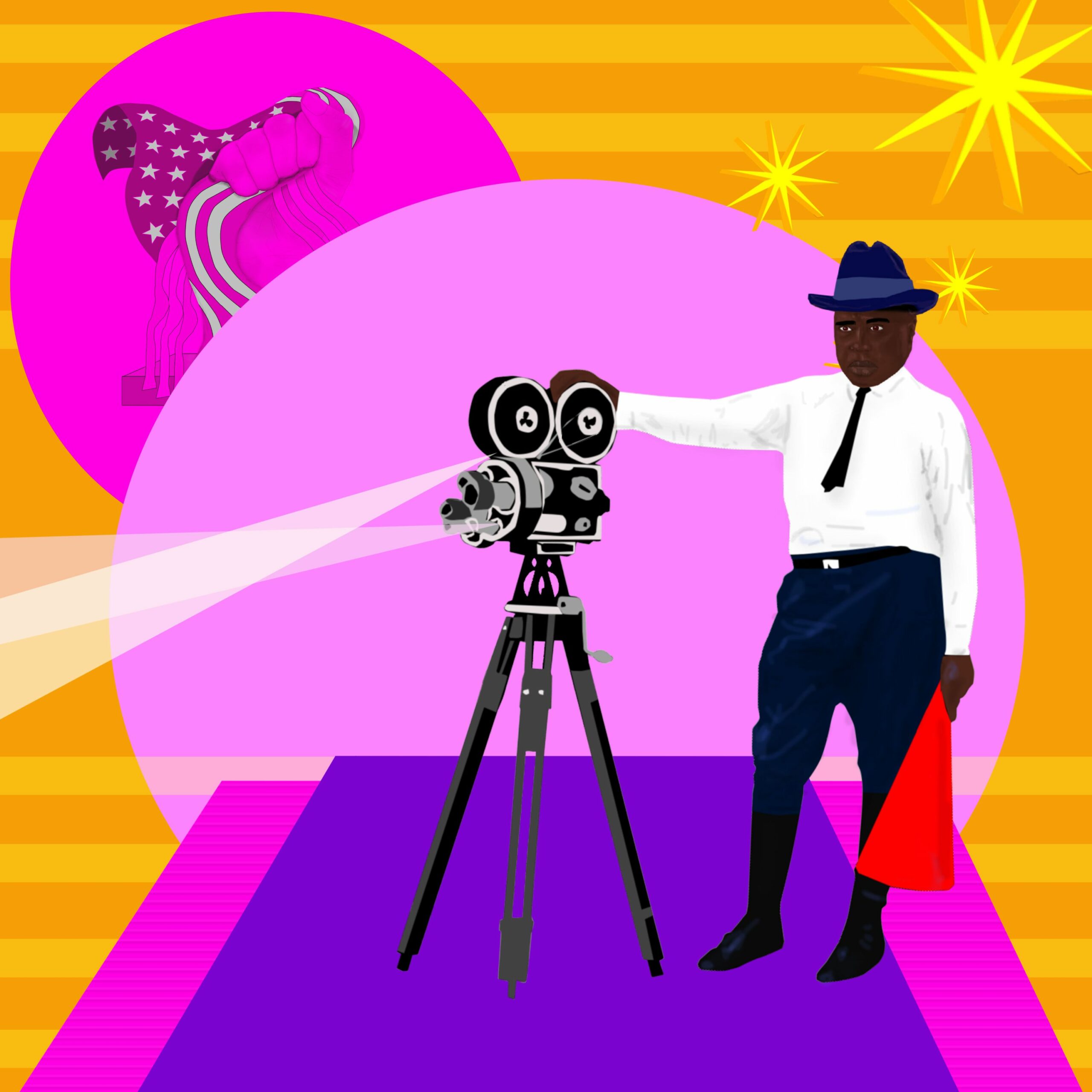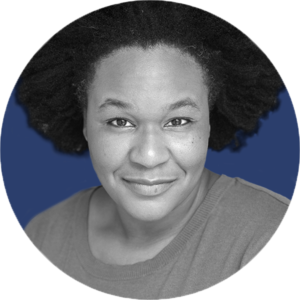
African Americans couldn’t seize much universal freedom as the brick-and-mortar of Jim Crow walled them off from their rights. Still, race men and women fought.
Following the death of three friends, instigated by the white press, Ida B. Wells committed herself to investigating and reporting the evils of lynching across the south, starting a newspaper in Memphis, Tennessee. It wasn’t long before her printing press was burned to the ground and she was forced to relocate to Chicago.
The windy city was witnessing the rise of Black Hollywood, inspiring race leaders like Wells and film producer Oscar Micheaux to harness the power of media to challenge the narratives being reinforced by racist newspaper reports and deeply problematic films like Birth of a Nation.
View Transcript
Kidada E. Williams: In the late winter of 1892, Ida B. Wells had an identity crisis.
Ida B. Wells: Until this past year, I was one among those who believed that when wealth, education and character became more general among us, justice would be accorded to all alike.
KEW: For a long time, she adopted the kind of attitude that framed Booker T. Washington’s career: that through hard work and self-sufficiency, Black Americans would achieve the full rights and freedoms of citizenship they’d sought for so long. And she believed in the power of the written word to spread that gospel.
IBW: I shared the general belief that good newspapers could do more to bring about this result than any agency. Preaching the doctrine of self-help, thrift and economy every week, they would be the teachers to those who had been deprived of school advantages, yet were making history every day. But there was a rude awakening.
KEW: That rude awakening involved a Black-owned grocery store owned by her friends. Thomas Moss owned a store called People’s Grocery in Memphis. Calvin McDowell was manager and Will Stewart was a clerk. They were well-known and popular Black men, and their business flourished.
This infuriated a white grocer in the neighborhood, William Barrett. Eager to find any reason to shut down People’s Grocery for good, Barrett instigated a fight on March 3, 1892.
IBW: Barrett drew his pistol and struck McDowell with it; thereupon McDowell, who was a tall, fine-looking six-footer, took Barrett’s pistol from him, knocked him down and gave him a good thrashing.
Barrett went to town, swore out a warrant for their arrest on a charge of assault and battery. Knowing how anxious he was to destroy their business, these young men consulted a lawyer who told them they were justified in defending themselves if attacked, as they were a mile beyond city limits and police protection.
KEW: The following Saturday night, Barrett strode into the front of People’s Grocery, while half a dozen white men came through the rear. Moss, McDowell, and Stewart assumed that a Klan attack was on and started shooting. They hit three men—who happened to be undercover deputies—who had done nothing to stop Barrett’s attack.
IBW: When these men found they had fired upon officers of the law, they threw away their firearms and submitted to arrest, confident they could later establish their innocence of intent to fire upon officers of the law.
KEW: Moss, McDowell, and Stewart were sent to jail to await trial.
IBW: Daily papers, in flaming headlines, roused the evil passions of the whites and denounced these poor boys in unmeasured terms.
KEW: Local Memphis newspapers warned that the People’s Grocery incident would be the beginning of an armed rebellion by Black men in Memphis. They made a big deal out of the suffering of the wounded white deputies and promised it would “go hard” on Moss, McDowell, and Stewart if the deputies died.
At around 2:30 in the morning on March 9, 75 white men wearing black masks took Moss, McDowell, and Stewart from their jail cells.
IBW: The mob dragged out these young men, hatless and shoeless, carried them a mile north of city limits to a train yard and horribly shot them to death while the locomotive let off steam and blew the whistle to deaden the sound of the firing.
“It was done by unknown men,” said the jury. Yet the Appeal-Avalanche, which goes to press at 3 a.m., had a two-column account of the lynching.
“It was done by unknown parties,” said the jury. Yet the papers told how Thomas Moss begged for his life, for the sake of his wife, his little daughter and his unborn infant. They also told us that his last words were, “If you will kill us, turn our faces to the West.”
KEW: The death of her friends—and the role the white press played in instigating it—changed the course of Ida B. Wells’ life forever.
IBW: It was our first object lesson in the doctrine of white supremacy; an illustration of the South’s cardinal principle that no matter what the attainments, character or standing of an Afro-American, the laws of the South will not protect him against a white man.
KEW: Knowing no one would stand up for her people unless she did, Wells committed herself to investigating and reporting the horror of lynch law across the South.
IBW: The way to right wrongs is to turn the light of truth upon them. Somebody must show that the Afro-American race is more sinned against than sinning, and it seems to have fallen upon me to do so.
KEW: This is Seizing Freedom. On today’s episode: how race leaders like Ida B. Wells used media—first print, and then film—to gain control of the narrative used to depict the challenges of being free, Black, secure and equal in Jim Crow America in the early 20th century.
In 1892, after the People’s Grocery lynching, Wells wrote an editorial in her newspaper, the Memphis Free Speech and Headlight, calling out a particular hypocrisy she saw in her investigations across the South.
She argued that while white communities lynched Black men after false accusations of raping white women, it was white men who actually preyed on Black girls and women—and white women who protected or aided white men in their lies.
IBW: I have been censured for writing that editorial, but when I think of the fact that not a week passes but some poor soul is violently ushered into eternity on this trumped-up charge, seeing that the whole race in the South was injured in the estimation of the world because of these false reports, I could no longer hold my peace.
KEW: Wells had lost faith in the law and self-sufficiency, but she still believed in the power of the written word—as long as the right people held the pen. To her, exposing the evils of lynching would surely lead to justice and action on the part of lawmakers.
IBW: The Afro-American is not a bestial race. If this work can contribute in any way toward proving this, and at the same time arouse the conscience of the American people to a demand for justice to every citizen, and punishment by law for the lawless, I shall feel I have done my race a service.
KEW: After that editorial, a mob set fire to Wells’ printing press and threatened her life. Wells was forced to leave Memphis behind. She eventually settled in Chicago, and in 1895 married Ferdinand Barnett.
Barnett was a well known race man—an activist who consistently fought for civil and political rights—and a newspaper man, too. He founded the Associated Negro Press. Together, Ida and Ferdinand were a force for justice to expose the truths about lynching.
In Chicago, Wells-Barnett would also find a new medium vying for control of the message: film. As more and more African Americans migrated to Chicago in the early 1900s, the cultural significance of theaters on the South Side blossomed. During the birth of moving pictures, theaters would often showcase a play, a vaudeville act, a few musical performances, and a silent film reel continuously, from about 2pm to midnight.
Most theaters—even in Black neighborhoods—were owned and operated by white people. And most required Black patrons to sit in the gallery, far away from the action, or attend separate viewings altogether.
It wasn’t until 1906 that Chicago would see its first Black-owned and managed theater. The Pekin Theater on South State Street in Chicago had been renovated from a saloon owned by the infamous “gambling lord of the South Side,” Robert T. Motts.
IBW: When I, therefore, received an invitation announcing that Motts had abandoned the saloon and was turning the place into a theater, I was very glad. I at once went to his place and told him that I had come to congratulate him on the change of business—that the reports I had from his place had given me many a heartache and that we would be very glad to cooperate with him in his new venture.
KEW: The rest of Black Chicago, however, didn’t exactly roll out the welcome mat. The efficacy of using theater space for expressing Black pride, progress, and narratives was contested—especially when owners had a reputation like Motts’. Almost no one came to his opening night.
Always ahead of the curve, Wells-Barnett recognized the possibilities of the new medium. In her mind, movies could be one part leisure, one part education—especially if the theaters were owned, operated, and staffed by Black Chicagoans.
IBW: I thought it our duty to forget the past and help Motts; that if he was willing to invest his money in something uplifting for the race, we all ought to help.
KEW: She planned a benefit for the theater and drummed up support from other mission-driven people and organizations in the city.
IBW: I described the beautiful little gem of a theater which he had created; told of the stock company of Colored actors he had gathered together; of the Negro orchestra composed entirely of our own musicians; and how all employees were members of our race, and how proud I was to see a payroll upward of a hundred persons employed by him. I felt that the race owed Mr. Motts a debt of gratitude for giving us a theater in which we could sit anywhere we chose without any restrictions.
KEW: Once people started to see for themselves that the Pekin Theater wasn’t a den of sex and sin…
IBW: …it became very popular. The society leaders vied with each other in their box and the house was filled with the most representative members of our race. A very auspicious effort was being made right here in our town by a man who sincerely wanted to do better things. We cleared five hundred dollars in cash for the benefit of the center and started the Pekin Theater on its upward march.
KEW: By 1912, movies had become a cultural force across the nation. The Chicago Defender included reviews in its entertainment pages—not just of films, but of the theaters that showed them.
Minnie Adams (theater reviewer for Chicago Defender): A moving picture show in a real theater is what attracts the attention and impresses itself on one’s mind when entering the Orpheum Photo Play house on State Street. The pictures are of the highest order, excellent films are used, and the house boasts of two singers; both singers have the most beautiful voices, which they use to a good advantage. The house is a very pretty one and the management and ushers are courtesy itself.
KEW: But because of Jim Crow, going to the movies could end in violence for Black folks. Though segregation was outlawed in Illinois in 1885, discrimination—even in the Black Belt of Chicago—was rampant.
In 1912, the Chicago Defender reported what they called “Dastardly Conduct” by white ushers against two Black patrons of the Columbia Theater.
Chicago Defender: The temptible poison that lurks so close to the surface in the blood of the lower class of the white race came to the fore last week when Mrs. Bolden purchased seats and was then told to go to the gallery or she could have her money back.
A few evenings before, Mrs. Bolden’s son attended the same theater and was ordered to take seats in the gallery or the ushers would “knock his block off.” Such demonstrations of prejudice, which is no more or less than another one of the “devil’s personalities”, should be nipped in the bud. The cause is very evident. The lowest type of white man can and does put on clean clothes, comb his hair and black his boots, and will naturally secure a position which one of us might try a lifetime for, no matter how aristocratic we may be.
KEW: In 1915, that “dastardly conduct” would make its way onto the silver screen in D.W. Griffith’s Birth of a Nation. Based on the play “The Clansman,” Birth of a Nation, a silent, epic drama, tells the story of two white families—one Northern and one Southern—who are opposed during the Civil War but unite in Reconstruction over the double marriage of their respective sons and daughters.
The plot includes several profoundly racist stereotypes played by white actors in blackface. In one scene, a newly elected Black congressman takes off his shoes, puts his feet on the desk, and tucks into some fried chicken. In another scene, a Black man pursues a white woman until she flings herself off a cliff. He’s then lynched by the Klan, who rally together to prevent another interracial marriage. An interstitial card lets the audience know: “The former enemies of North and South are united again in common defense of their Aryan birthright.”
The portrayals of Black men and women—and their relationships to white characters—in Birth of a Nation justified, for many white people, Jim Crow’s most lethal power: lynching. Booker T. Washington had called for the film to be banned before it could be shown.
Booker T. Washington: The play is fundamentally wrong in that it attempts to deal with the development of America since the abolition of slavery by ignoring the substantial progress of the Negro race and emphasizing the cruel misunderstandings of the Reconstruction period, in which unfortunate individuals of both races figured. No matter how many other artistic and historic features the play may have, its ultimate result will be to intensify race prejudice and thereby do great and lasting harm to both races.
KEW: Activists had early success in Chicago.
Chicago Defender: Mayor Thompson bars Birth of a Nation from Chicago. Courageous executive refuses promoters a permit to exhibit films based on “The Clansman” in the city. Takes High Ground in defense of many nationalities that make up his constituents. Will allow no race to suffer ridicule.
KEW: Other cities had less success. Over the course of the year, the NAACP pivoted from boycotts and sought to get only parts of the film censored—re-cutting Griffith’s vision and re-releasing it without some of the worst scenes. Griffith sued to have Birth of a Nation shown in Chicago theaters. As he testified on the witness stand, Wells-Barnett was camped in the back, taking notes.
IBW: Mr. D. W. Griffith, the creator of the film, took the stand and denied that there was anything in The Birth of a Nation which could be objected to. The NAACP, which was supposed to be functioning in the matter, had failed utterly to prepare itself to make the showing.
It was a veritable farce of a trial. One could not blame Judge Cooper for refusing to grant an injunction against The Birth of a Nation when no case had been made out to show him why he should do so, and especially when so little interest had been shown by the Colored people themselves. I sat in the courtroom all day and was disgusted at the poor showing made.
KEW: Though Griffith would go on to win the trial, Wells-Barnett pulled no punches and published her own snide critique of the film.
IBW: D. W. Griffith was a great artist and one of the leading geniuses in presenting photo plays. I have often wondered if his failure to establish himself as a moving picture magnate is because he chose to prostitute his magnificent talents by an unjust and unworthy portrayal of the Negro race.
KEW: By the end of 1915, distributors could show Birth of a Nation in almost any theater in the country—with minor edits to the film’s content (and none that retracted the most racist plot points). Over the next 20 years, it would become Hollywood’s most profitable film, to be replaced only by another film glorifying the Lost Cause: Gone With the Wind.
Also by the end of 1915, Ida B. Wells-Barnett turned her attention away from D. W. Griffith and back to reporting on injustice. One night, she was reading about a Black man at a penitentiary in Joliet, Illinois—just 30 miles southwest of Chicago. His name was Joseph Campbell. He’d been doing time for a murder, had worked as the personal attendant to the warden’s wife, and had been set to appear before the parole board for his trustworthy behavior.
But a week before his appointment, the warden’s wife was found murdered in her room, and Campbell was immediately accused of the crime. The evening papers reported that Campbell was being kept in solitary, and had been denied food and water for 40 hours.
IBW: As I sat down to my dinner, it seemed as if the food would choke me. When asked by my family what was the matter, I replied, “When I think of that poor devil being persecuted down there in the penitentiary, the reports assuming that he was the guilty party without giving him a chance to defend himself, I can’t eat. The whole plan is to shape itself into proving him guilty, and here we are, seventy thousand Negroes sitting up here in Chicago enjoying ourselves, and giving no concern whatever to his plight.”
Just at this moment my doorbell rang and two women friends came in to tell me that they had just been to see The Birth of a Nation and agreed with me that it was an outrage which ought never to have been allowed to be shown here. I said to them, “I am not worrying about that any more. I am worrying about that colored man down in Joliet.”
KEW: Wells-Barnett wrote to Campbell and offered him legal help in the form of her husband, Ferdinand Barnett.
IBW: From that moment we began the work of trying to secure the money to pay the necessary expense of his case. We had much help from what they call the common people, who gave their mite to help a man whom they believed to be an innocent victim. We put a man in the field who canvassed all of our leading politicians, doctors, lawyers, and prominent people, not one of whom gave a dollar to help this man prove his innocence.
KEW: Barnett spent six weeks traveling back and forth between Chicago and Joliet. Despite their efforts, Campbell was found guilty and sentenced to be hanged in 1916. Barnett appealed to the Supreme Court and got the sentence commuted to life in prison, instead.
Because white papers typically acted as stenographers for the white power structure, Black defendants often received swift executions by lynch mob or by the state. This made Black media all the more valuable. Media like: Wells-Barnett’s work, reporting from Black papers across the country, and editorials in The Crisis, the magazine published by the NAACP and edited by W.E.B. Du Bois.
Wells-Barnett, her husband, and their network of activists had success with individual cases, but fighting white supremacy on a grand scale through print was a tall order. In 1917, East St. Louis, Illinois—just across the Mississippi river from downtown St. Louis, Missouri—was the site of a massacre that once again called Wells-Barnett into action. The Crisis reported:
The Crisis: On the evening of July 1, white “joyriders” rode down a block on Market Street, which was inhabited by Negroes, and began to fire into the houses. The Negroes, aroused by this, armed themselves against further trouble. Presently a police automobile drove up containing detectives and stopped. The Negroes, thinking that these were the “joyriders” returning, opened fire and two of the detectives were killed. Some of the policemen were in plain clothes.
KEW: For three days, white people rampaged. Spurred by the deaths of the detectives and fury that Black East St. Louisans would defend themselves, the rioters burned through neighborhoods, beating and killing men, women, and children. Thousands of Black people streamed across the bridge to St. Louis. Police responded by closing the bridge. Some of those trapped there jumped into the Mississippi River to escape, but drowned instead.
An Associated Press dispatch of July 10th, 1917, from East St. Louis had the following:
Associated Press: A man arrested by Capt. O.C. Smith was released by the police, ostensibly “on order of the state’s attorney.” Captain Smith asserted that he heard the man say: “I’ve killed my share of Negroes today. I have killed so many I am tired and somebody else can finish them.”
KEW: As she did in Joliet, Wells-Barnett rushed into the aftermath to speak with eyewitnesses. In East St. Louis, she met dozens of women traveling back and forth across the Mississippi, trying to salvage their homes and belongings and find their families. She gathered their stories and published them in a pamphlet, “The East St. Louis Massacre: The Greatest Outrage of the Century.”
IBW: Mrs. Emma Ballard, with her husband George Ballard, have lived in East St. Louis seven years.
Emma Ballard: We had been married twenty-four years and came here from Jackson, Tennessee. We had a six room house, nicely furnished. In this home was a piano. We have four children.
IBW: Mrs. Flake is a widow with three children, 11, 8 and 6 years old.
Mrs. Flake: I am a laundress who came to East St. Louis four years ago from Jackson, Tennessee. The mob had taken a phonograph for which I had paid $15 and twenty-five records. I got away with my children before the mob reached my house and I too came back that morning to get some clothes for myself and children.
IBW: Mrs. Dolly Bruton, another widow, came to East St. Louis from Mississippi, December 8th, 1915.
Dolly Bruton: I had seen a good part of the rioting Tuesday, but had not been disturbed myself. I thought it was because my house was right between the homes and stores of some of the white people.
IBW: Mrs. Thomas’ house had been set on fire…
Mrs. Thomas: The mob had broken in the door, broken out the windows, dragged some of the mattresses out and set fire to them; they left others in the room, cut, torn and burned. My pictures and bed clothes, wearing clothes, furniture, all broken and torn and thrown about.
Emma Ballard: The children and I heard the first of the mob between 12 and 1 o’clock Monday night. Men and boys were in the street hollering, “Come out, n—-s” as they roamed up and down in the Negro district. They shot and beat every Negro found on the streets Monday night. I saw fourteen men beaten and two killed.
Dolly Bruton: The street cars ran right along in front of my house, and I saw white women stop the street cars and pull Colored women off and beat them. One woman’s clothes they tore off entirely, and then took off their shoes and beat her over the face and head with their shoe heels.
Emma Ballard: I took my children and got away with what we had on, after trying to hide some of our best things. I did not come back to East St. Louis until the morning of the 5th. After a day of uncertainty I found my husband, who had already found a home in St. Louis and we’re going to stay there.
Mrs. Flake: I too had already found a flat in St. Louis and was only too anxious to get away from the town where such awful things were transpiring, and where not even the widows and children were safe from the fury of the mob bent on killing everything with black skins.
IBW: Such is the present state of unrest at this writing. No one has any feeling of certainty that anything will be done, either to punish the rioters or to make the lives and property of Negroes more secure permanently.
KEW: The only remedy that Wells-Barnett could see for lynching and rioting would be to make them federal crimes. And the best path toward an anti-lynching bill would be to use media to change national hearts and minds.
IBW: Public sentiment, which has encouraged lynchings by silence or by sensational newspaper accounts, must be aroused to see the evil done to the whole American Nation.
KEW: Anti-lynching bills had been proposed in Congress since the 1890s, but nothing—not even reading the reports of the women in East St. Louis—had stirred the government to act.
Meanwhile, Chicago was witnessing the rise of Black Hollywood, which was also fighting for American hearts and minds. In 1915, an editorial in the Chicago Defender suggested that Black people make a counter film to Birth of a Nation. But it would be another five years before Chicago’s Black Hollywood would have the means—and the man—to make such a film.
Chicago Defender: Film producer Oscar Micheaux has contracted with some of the most prominent and widely known actors and actresses of the race. He reports great activity in the building of new picture theaters by and for the race in the East and South and the subsequent demand for more and better photoplays acted by racial casts from stories concerning the lives of our people.
KEW: Oscar Micheaux grew up in Illinois. He worked in the steel mills outside of Joliet and as a Pullman Porter. But he left the city after a few years; lured by stories of the west, he set out to become a farmer in South Dakota.
There was something romantic inside Micheaux, though, that farming couldn’t satisfy. The plains inspired him to write, and in 1913 he began self-publishing semi-autobiographical novels. Maybe it was the sense of freedom he felt out in South Dakota, where no one seemed to be telling him how to live or what he could and couldn’t create. Capitalizing on the success of his novels, he bought a camera and started making movies.
Micheaux returned to Chicago in 1918—a year after the riot in East St. Louis—and opened a silent film office in the South Loop. Newspapers across the nation, from the Chicago Defender to the Black Dispatch out of Oklahoma, covered his rising career and his every move.
Chicago Defender: Producer returns! Oscar Micheaux, the prominent moving picture producer who recently returned to the city, has written a series of features as well as comedies, and has already started the production of a new picture.
Black Dispatch: Micheaux has practically completed his latest movie production, which is said to be his most pretentious effort and is greatly encouraged by the business outlook for the year. To the Associated Press, he said:
Oscar Micheaux: By all of us working together, we cannot only raise the standard of our commercial achievements, but we can give employment to the growing talent of our race.
KEW: Micheaux’s first film, The Homesteader, premiered in 1919. An ad for the film in the Chicago Defender highlights just how much “race films” mattered, even off screen:
Ad Man: Oscar Micheaux’s mammoth photoplay “The Homesteader”—a powerful drama of the Great American Northwest featuring an All-Star Negro cast. George Garner, Jr., greatest Negro tenor, will sing at each performance. Colored people seated anywhere in the house!
Note: This wonderful and spectacular production, the first great creation from the pen of a Negro ever screened, was held up by the board of censors for the city of Chicago until reviewed by a committee of the better class of both races, who unanimously proclaimed it to be the most masterful portrayal for many a day. Needless to say the production was duly released and is now playing to great crowds in more than a dozen houses in that city, Black and white.
KEW: But 1919 was also one of the most violent years for lynching and white rampages on record. The violence was the result of the convergence of unjust policies and racist violence and racist media lies about both. Chicago, where moviegoers were flocking to matinees of Micheaux’s film, was the epicenter of “Red Summer.”
The city convulsed with street fights, fires, beatings, and shootings. Once again, white people rampaged. But this time, fed-up Black Chicagoans, drawing on their lineage of resistance and embracing New Negro assertiveness and militancy in the face of white supremacy, fought back.
Ida B. Wells-Barnett kept busy that year. In September, she got word of a mass murder in Elaine, Arkansas. Black farmers there had been pressured to sell their cotton below market price—but were refusing—and gathered in a local church to bolster their union.
IBW: The place was crowded with men, women and children. A peaceful, law-abiding, hard-working group in their own church, attending strictly to their own business, about two hundred of them. Suddenly at 11 o’clock at night, without warning, a volley of shots are fired into this free assembly. The lights go out and those who are not killed or wounded get away as quickly as possible.
No one knows how many of these peaceable, unoffending Negroes were killed by this volley, as the persons who did this dastardly deed burned the church down the next day so no bullet holes in the walls, broken windows or dead bodies of Negroes would show the conspiracy of whites to kill Black people. One white man, W. A. Adkins, is killed out in front of this church.
KEW: Media reports at the time couldn’t confirm how Adkins died. They speculated that he was killed by accident, by one of the white men firing into the church. But those white men weren’t arrested. Instead…
IBW: After scores of helpless Negroes were killed, scores more of them were herded into prison in Helena, Arkansas, where the mob tried to lynch them and where they were shocked by electricity, beaten, and tortured to make them confess they had a conspiracy to kill white folks. After the mockery of a trial, twelve of them were sentenced to be electrocuted!
KEW: Wells-Barnett immediately put her pen to use to try to rescue them. She wrote a letter to the Chicago Defender, outlining the context and facts of the slaughter at the church and the farce of the trial.
IBW: The letter had a widespread response. Many people all over the country sent in contributions to assist in securing legal talent. But no word of help had come from the prisoners’ own people until a copy of the Chicago Defender, December 13th, fell into their hands!
Frank Moore: Dear Mrs. Wells-Barnett: This is one of the 12 men who is sentenced to death, speaking to you on this day and thanking you for the speech you made throughout the country in the Chicago Defender paper.
So I am thanking you to the very highest hope you will do all you can for your Colored race. Because we are innocent men. We were not handled with justice at all. It is prejudice that the white people had against we Negroes. So I thank God that through you, our Negroes are looking into this trouble, and thank the city of Chicago for what it did to start things and hope to hear from you all soon. Please pray for us, I am a Christian man. Please Chicago, let us hear from you at any time.
IBW: In response to this cry, the writer took the train for Little Rock, Arkansas.
KEW: It was the first time Wells-Barnett had been back in the South after her printing press was destroyed in Memphis in 1893.
IBW: I talked with some of the wives of the twelve, then went to the penitentiary and spent the day interviewing those men. Mrs. Moore said, “Boys, don’t you want to sing for my cousin?” Whereupon they sang a song of their own composition.
[Recording of “I’ll Just Stand and Wring My Hands and Cry” by Ed Ware plays]
IBW: I came back to Chicago, wrote my pamphlet about the Elaine rioters, raised the money to print a thousand copies, and circulated almost the entire edition in Arkansas.
KEW: In the following winter, one of the twelve that had been imprisoned in Arkansas knocked on Wells-Barnett’s door.
IBW: He was well dressed and had been living in Chicago for three months; he said he had been looking for me all that time. He wanted to tell me how much he felt indebted for my efforts. When my family came in to be introduced, he said, “Mrs. Barnett told us to quit talking about dying and to pray instead. After that,” he said, “we never talked about dying any more, but did as she told us, and now every last one of us is out and enjoying his freedom.”
KEW: While Wells-Barnett was in Arkansas, Oscar Micheaux was in Chicago trying to get his next film released. This one was an epic response to the wave of violence against Black people sweeping the country; to the failure of the government to recognize Black people’s rights, despite their contributions during World War I; and to the success of Birth of a Nation.
That movie would become Within Our Gates. Featuring a large cast of Black actors, Micheaux set out to refute racist stereotypes by showcasing a variety of characters that led radically different lives. Unlike Birth of a Nation, this movie showed there were no simple divisions between North and South, “good” and “bad.”
The plot covers a lot of ground in its 70 silent minutes. It centers on the life of a Black woman, Sylvia Landry, who spends the first act of the film being courted and going to Boston to try to drum up funds for a failing Southern school. Later, Sylvia’s adoptive, sharecropping parents are falsely accused of murdering a white landowner. They are captured, hanged, and burned.
It’s a gruesome scene that is interspersed with another: as her parents meet their doom, Sylvia is cornered by the landowner’s brother, who tries to rape her. At the last minute, he stops. A birthmark on Sylvia’s chest reveals that she is actually his daughter—the product of a relationship he had with a Black woman.
All of these themes—funding schools, migration between north and south, sharecropping, lynching, and rape—were the undercurrents of modern life that any Black audience would have recognized on the screen.
In 1920, an editorial in the Alabama newspaper The Emancipator emphasized the cultural importance of “race movies” like Within Our Gates. Like the “race papers” that preceded them, these films were produced specifically for Black audiences.
The Emancipator: For many years it has been a favorite theme of our orators, when they have grown eloquent, in proclaiming that “the great trouble with our people is, we are consumers and not producers.” The conditions are changing. The times are different. The pioneers of commercial ventures into the land of production are marching on to success, and the eloquent orators will have to wax eloquent in admonition and warning on some other theme.
KEW: And that didn’t sit well with local white censorship. Many of them fought to keep the film from being shown. They wanted to prevent Black audiences from potential rioting at the depictions of lynching and interracial rape.
In a letter to a board of censors in Virginia, Micheaux tried to put their minds at ease, reminding them that it wasn’t the truth that instigated backlash from Black audiences, but stereotypes, lies, and violence done to them:
Oscar Micheaux: You are unduly alarmed as to how my race is likely to take the film. There has been but one picture that incited the Colored people to riot, and that still does; that picture is Birth of a Nation.
KEW: Nevertheless, Within Our Gates—like most of Micheaux’s films—was routinely censored and recut before it was shown. Still, newspaper accounts and advertisements sang the film, and the director’s, praise. An editorial in The Emancipator read:
The Emancipator: Mr. Micheaux is not the first movie producer, but he is the first to have the vision and the daring to lift the art to a plane of high intelligence and serious motive. That he has seen with the eyes of wisdom, is attested by the tremendous success of his productions.
Mr. Micheaux reached the sensible conclusion that the public wants realism, plot and elevation. So the stories of his pictures are everywhere true to life. He shows the world that we have the talent to produce the best. When occasion demands, he dresses his performers in the most appropriate costumes, and places them in the most beautiful and desirable surroundings, knowing that the public appreciates the reality of it all in our everyday life. Thus we have produced a producer, who produces the things that measure up in the cause of education and Race Adjustment.
KEW: When it was finally released in 1920, the Kansas City Sun reported that Within Our Gates was coming for an “indefinite engagement”; they’d run the film as long as they could fill the seats.
Micheaux would go on to produce more than 44 movies—crossing over from silent film into the sound age—and Ida B. Wells-Barnett continued to write, investigate, and agitate.
That same year, Congressional Republicans included a federal anti-lynching bill as part of their platform. But Southern Senate Democrats maintained a united front against such a bill throughout the 1920s, defeating it three times by filibuster.
IBW: Eternal vigilance is the price of liberty and it does seem to me that all these social agencies and activities lack that vigilance which should be exercised in the preservation of our rights.
KEW: By this time, Wells-Barnett was disillusioned by the lack of federal movement on lynching.
IBW: This leads me to wonder if we are not too well satisfied. We point to our wonderful institutions with complacence and draw the salaries connected therewith instead of being alert as the watchman on the wall.
KEW: Today, one hundred years later, the Emmett Till Anti-Lynching Act—which would define lynching as a hate crime and punish the perpetrators with prison and fines—recently passed both the House and the Senate. This looks like progress. But if this history has taught us anything, it’s that it’s too early to tell.
By the late 1920s, a new freedom movement was gaining steam, though its advocates—like Wells-Barnett and Micheaux—wouldn’t live to see it. For many African Americans, the pervasiveness of Jim Crow was distressing, disturbing, deceiving, and dispiriting. They and their collaborators—new arrivals from the Caribbean and white progressives—were down, but not out.
African Americans couldn’t seize much universal freedom as the brick-and-mortar of Jim Crow walled them off from their rights. Still, race men and women fought: to narrate their own story, to register their indignation at the injustices they faced, to safeguard the spirit of the generations to come, to protect their health, and against the racist violence and racist narratives that fueled it all. Those individual shards of light in the darkness of early Jim Crow inspired more people to lean deeper into their heritage of seizing freedom.
A new world was taking shape. New Negroes were rising, laying the foundation for their path back to liberation. In a nation that has a professed respect for the law, activists knew that the law was the way forward. Activists set the law in motion: filing lawsuits, forming and joining civil rights organizations to wage collective fights, staging larger protests, and creating artistic work that told their story. They would use every weapon in their arsenal to dismantle each brick of Jim Crow.
The law was torturously slow but each win established a new legal precedent and inspired more protests. In time, that fight would grow into one of the most revolutionary freedom movements of the 20th century.
Voice Actors

Aaron Goodson
Voice of Chicago Defender

Candice Holley
Voice of Mrs. Flake, Mrs. Thomas

Chiquita Melvin
Voice of Minnie Adams

Conrad Haynes
Voice of Oscar Micheaux

Dustin Ebaugh
Voice of Associated Press

Eric Hollaway
Voice of Ad Man

Frank Harrison, Jr.
Voice of The Emancipator

James J. Johnson
Voice of Black Dispatch

Jasmine Bracey
Voice of Emma Ballard

Jefferson A. Russell
Voice of Booker T. Washington

Madyun Shahid
Voice of Frank Moore

Richelle Claiborne
Voice of Ida B. Wells-Barnett, Dolly Bruton

Ronald Young, Jr.
Voice of The Crisis
Episode Resources
The following resources were utilized in the research and creation of this episode:
- Mia Bay – To Tell My Truth Freely: The Life of Ida B. Wells
- Alfreda Duster – Crusade for Justice: The Autobiography of Ida B. Wells
- Jane Gaines – Fire and Desire: Mixed-Race Movies in the Silent Era
- Paula Giddings – Ida: A Sword Among Lions: Ida B. Wells and the Campaign Against Lynching
- J. Ronald Green – Straight Lick: The Cinema of Oscar Micheaux
- Anna Siomopoulos – “The Birth of a Black Cinema: Race, Reception, and Oscar Micheaux’s Within Our Gates”
